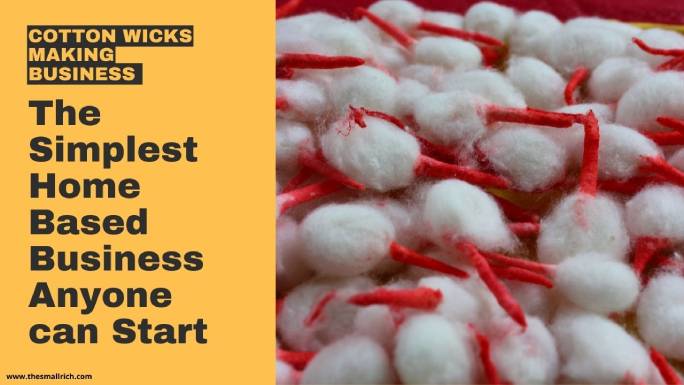Cotton wicks are one of the common commodities in India as well as several Asiatic nations used for spiritual activities. The use of cotton wicks or diya batti as part of ritual items can be traced back to thousands of years. Today we will learn what cotton wicks are and how to start a cotton wicks making business and why it is considered one of the best home business
What are Cotton Wicks and Why they were used?
Cotton wicks are small thread like structures made out of cotton. They were either hand rolled or machine rolled to give them a thread-like form. These wicks are immersed in oil for lightening purposes.
Most of the cotton wicks are used for ritual purposes where they will be placed in diyas(earthen lamps). In some cases, the cotton wicks are also immersed in ghee which are especially used during festive occasions as the cotton wicks that are dipped in ghee are known to bring positivity

Why Cotton Wicks Making Is a Popular Home-Based Business?
Cotton Wicks making is a very simple process they can be done using simple hand tools that are mostly available in and around the grocery store. This business can be started with less than 10,000 rupees making it a popular home based business
In countries like India and Nepal women of the house usually make them with their hands and sell them in towns or cities for very small income. But cotton wicks making machine changed the fate of several women in rural areas by increasing the production capacity and also their earning capacity
Along with that, it is a business where you don’t have to worry about the shelf life of the products, you don’t need special storage conditions, there are very less chances of damage and no expiry to the product
Especially in India where Hindu culture is predominant, cotton wicks are used daily for pooja purposes in homes, shops, temples, and industries so, there is a constant requirement for this product in market making it a go-to business
How to Start a Cotton Wicks Making Business – 5 simple steps
The process of setting up a cotton wicks business is simple. However, you need to have certain business knowledge to sell and market your products. Here are the 5 simple steps involved in making cotton wicks or diya batti’s
Step 1: Procure Raw materials and Equipment
The first step in this business starts with getting the resources to make cotton wicks. Raw cotton is the main resource required for making cotton wicks. It is easily available across all markets. The amount of raw cotton to be procured should be equal to quantity of cotton wicks you would like to prepare
Next, you need a cotton wicks making machine. The price of the machine ranges from 10,000 to 50,000 rupees
Before purchasing a cotton wicks making machine, one must decide to check the following features
- strokes per minute
- production capacity per hour
- Type of cotton wicks it makes (round cotton batti or long cotton wicks)
- Mode of operation (automatic or semi-automatic)
Step 2: Registering your Business
Cotton wicks making mostly comes under small scale, home based industry. Unlike a business that needs high investment and manpower; cotton wicks is a type of business that can be started off from home itself so in most of cases this can be registered as a sole proprietor business
Step 3: Documentation and Paper Work Requirement
As this one comes under small scale business; one would require minimal paperwork to set up this business. Here are some important documents and formalities required for this business
- Aadhar card
- PAN Card
- GST if you are registering under MSME
- Bank account
- Address details of the place of manufacturing
- Trade license
Along with the above, please also check if any additional requirements documents are required as per your state government
Step 4: Cotton Wicks Making Process
Cotton wicks making is a very simple process, it can also be done by single person manually without any use of machines; However, the use of cotton wicks making machine greatly increases the production capacity and would also provide better rolling of the wicks which gives them strength
The typical process of making cotton wicks or Diya batti goes as below
- A handful of raw cotton is taken and slightly rolled on the top by applying a little water
- This piece is then put into the cotton wicks making machine, which rolls the cotton into thread by applying slight rolling pressure
- A bunch of such threads are tied together and packed into small boxes which are ready to sell in the market
- In some cases a bulk amount of cotton wicks packs are sold to an enterprise on bases of buy back agreement; However, one must double check the genuineness of the owner that is proving buyback business for making cotton wicks
Step 5: Marketing and Selling of Cotton Wicks
The popular way to market and sell cotton wicks is by reaching out to enterprises and wholesale dealers. One can also directly approach pooja stores which have great demand for these items and sell them without middle man
When it comes to marketing, one can follow simple techniques such as mouth publicity, giving small ads in local newspaper, and reaching out to small social media influencers
One of the ideal ways to increase your selling capacity is to ensure you make the finest cotton wicks and ensure the quality remains the same throughout the pack
To increase the chances of growing your business capability, one needs to grow their connection. You can do this by joining Mahila sahakara sangha or dwakra groups which are small cooperative societies run by women that help in providing capital and marketing your products
Another way to market Diya Batti’s is to grab the festival season opportunity. Special occasions like Diwali, Dasara, and Karthika Masam has a high demand for the Diya batti or vattulu so ensure to reachout to maximum distributors to sell your products in bulk for maximum price
Although people rarely pay attention to which brand of cotton wicks they are getting, If you provide fine quality wicks that are generally made out of unbleached cotton, and ensure the threads have decent strength and come in a good packing, Then people will definitely keep a note of your brand
Profit Margin in Cotton Wicks Business
One can expect a reasonable profit from making the cotton wicks. The profit depends upon the quality and the quantity of cotton wicks you make. The main budget goes into getting raw cotton, packing materials, and marketing.
In addition, one can easily buy a cotton wicks making machine without a loan or finance as a decent machine costs less than 25,000 rupees
Here’s a simple profit margin estimation for cotton wicks…
For example, 1 kg of cotton wicks is sold at around a price of 250 rupees in the wholesale market. 1 Kg of raw cotton costs around 20 rupees, A normal cotton wicks making machine on average can make 5 – 6 Kgs per hour. If you make 5 Kg of cotton wicks daily, you require 100 rupees for cotton and on average 50 rupees for electricity
Let’s assume it takes another 100 rupees for packing and labeling and 100 for marketing and selling, So overall it costs you 350 rupees for making, marketing and selling a 5 Kg of cotton wicks
Taking into account the average price of 1 kg cotton wicks as 250 rupees, you can sell 5 kg cotton wicks for 1250 rupees which means a profit of 900 rupees. However, depending upon the market demand and the competition you may either end up making more or less
So, the unique thing in the cotton wicks making business is, profitability is highly dependent on the quantity sold as well as customer/market demand
Moreover, you cannot expect the vendors to buy your products in bulk every time. It completely depends upon the market demand. If the season is high you can boost production and make good profits, if the season is dry your products may not sell quickly which means you have to slow down the production for a while
Overall, a cotton wicks making business is a decent small scale business that can be started with very minimal investment and can be run by a single person directly from home
